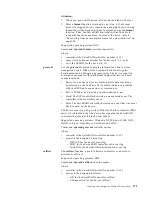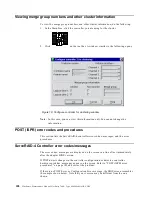
Installing and configuring ServeRAID controllers
169
Error-recovery functions
The IPSSEND error-recovery functions include the following:
getstatus
Use the getstatus function to display the current logical-drive status for the
most recent rebuild, synchronization, or logical-drive migration. The status
includes such information as the remaining size of the logical drive, the
percentage completed for the function in process, and information about the
most recently completed logical-drive function.
Supported operating systems: Windows NT, Windows 2000, OS/2, NetWare,
Linux, OpenServer, UnixWare, and DOS
Command: ipssend getstatus controller
where:
controller is the ServeRAID controller number (1–12)
rebuild
Use the rebuild function to rebuild a designated disk drive. This function is
valid for disk arrays that contain one or more logical drives that are in the
critical state. Progress is indicated during the rebuild operation, but you can
also use the getstatus function to obtain progress information about the
rebuild.
Supported operating systems: Windows NT, Windows 2000, OS/2, NetWare,
Linux, OpenServer, UnixWare, and DOS
Command: ipssend rebuild controller dch dsid nch nsid
where:
•
controller is the ServeRAID controller number (1–12)
•
dch is the channel number for the defunct drive (1, 2, 3, or 4)
•
dsid is the SCSI ID for the defunct drive (0–15)
•
nch is the channel number for the new drive (1, 2, 3, or 4)
•
nsid is the SCSI ID for the new drive (0–15)
setstate
Use the setstate function to change the state of a physical device from its
current state to a new state.
Attention:
You must be very careful when you use this function. For example,
you might lose data if you reset a defunct device to online without first
performing a rebuild operation.
Supported operating systems: Windows NT, Windows 2000, OS/2, NetWare,
Linux, OpenServer, UnixWare, and DOS
Command: ipssend setstate controller channel sid nstate
where:
•
controller is the ServeRAID controller number (1–12)
•
channel is the channel number for the drive (1, 2, 3, or 4)
•
sid is the SCSI ID for the drive (0–15)
•
nstate is the new state for the drive. Valid states are:
— EMP for Empty
— RDY for Ready
— HSP for Hot spare
— SHS for Standby hot spare
— DDD for Defunct disk drive
— DHS for Defunct hot spare
— RBL for Rebuild
— SBY for Standby
— ONL for Online.
Summary of Contents for 86655RY - Netfinity 7600 - 8665
Page 1: ...IBM Hardware Maintenance Manual Netfinity 7600 Type 8665 Models 1RY 2RY ...
Page 2: ......
Page 3: ...IBM Hardware Maintenance Manual Netfinity 7600 Type 8665 Models 1RY 2RY ...
Page 10: ...viii Hardware Maintenance Manual Netfinity 7600 Type 8665 Models 1RY 2RY ...
Page 52: ...42 Hardware Maintenance Manual Netfinity 7600 Type 8665 Models 1RY 2RY ...
Page 104: ...94 Hardware Maintenance Manual Netfinity 7600 Type 8665 Models 1RY 2RY ...
Page 148: ...138 Hardware Maintenance Manual Netfinity 7600 Type 8665 Models 1RY 2RY ...
Page 252: ...242 Hardware Maintenance Manual Netfinity 7600 Type 8665 Models 1RY 2RY ...
Page 270: ...260 Hardware Maintenance Manual Netfinity 7600 Type 8665 Models 1RY 2RY ...
Page 271: ...Related service information 261 ...
Page 272: ...262 Hardware Maintenance Manual Netfinity 7600 Type 8665 Models 1RY 2RY ...
Page 273: ...Related service information 263 ...
Page 274: ...264 Hardware Maintenance Manual Netfinity 7600 Type 8665 Models 1RY 2RY ...
Page 284: ...274 Hardware Maintenance Manual Netfinity 7600 Type 8665 Models 1RY 2RY ...
Page 285: ...Related service information 275 ...
Page 292: ...282 Hardware Maintenance Manual Netfinity 7600 Type 8665 Models 1RY 2RY ...
Page 293: ......
















































